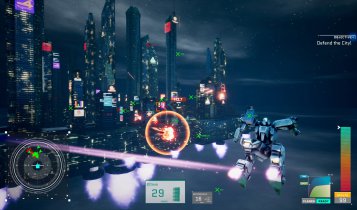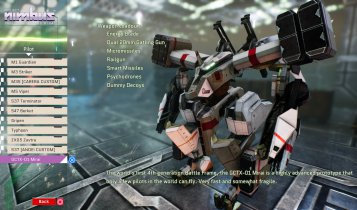Project Nimbus. In which mechs blow each other up because that’s what mechs do.
The whole mech sub-genre seems to have disappeared in recent years. There was a time when high-speed, robot-on-robot action, or lumbering tank-on-legs warfare was fairly common, with the likes of Armoured Core, Steel Battalion, and the Mechwarrior series providing plenty of ways to get your ‘giant stompy robot’ on. Recently though, there hasn’t been so much. Sure, there was Hawken, and Mechwarrior Online, but beyond that there has been little, especially of the high speed variety. Enter Project Nimbus: Code Mirai, the console release of the PC title released last year.

Project Nimbus is a high speed, 3rd-person, mech combat game in the vein of Zone of the Enders and Armoured Core. You’ll fly your Battle Frame through the air at insane speeds, fighting off other robots and ships using guns, missiles, and energy swords as a war between future-Russia and the future-USA rages. It seems that after World War 3, the Earth was left in an unfit state to live, so wealthy groups launched cities into the sky.
The plot isn’t too clear, to be honest. the cutscenes are really just mission briefings and don’t do too much to explain what’s happening, although there are audiologs available before each mission to fill in more detail. Even so, I wasn’t too sure why exactly I was exploding mechs.
Most missions boil down to either destroying all the enemy units, or protecting some of your own, and each tend to last between 5 to 15 minutes. Combat is very fast paced, with you flying around using the left and right sticks along with Triangle and X for ascending and descending. L2 will sending you flying even faster, whilst R1 and R2 handle the locking on and firing respectively. The default controls weren’t ideal for me, with the D-pad handling weapon changes (which is something you’ll do a lot) meaning you’re often taking your thumb off the left stick, limiting your movement. Thankfully these can be remapped as you see fit. Most combat involves locking onto a target, and flying around it to keep it on screen whilst the firing is automatically aimed. Enemies tend to be quite evasive, so you’ll find yourself using homing weapons often.

You’re often outnumbered, and will find yourself being attacked from every angle. Your Battle Frame is quite durable in most missions, that said, and can withstand a fair bit of punishment, but the sheer volume of missiles, guns, and energy beams will overwhelm you if you don’t keep moving. Boosting at the right moment (read: “all the time”) will avoid a lot of damage, but you’ll often rely on your Frame’s regenerating flares to keep enemy missiles off you. The amount of things happening at once can be quite intense, and it makes some of the later battles quite exciting as you take out grunts and hold off the more powerful enemies until you’re in a better position to attack them without getting swarmed. It’s times like these that Project Nimbus is at its best, when all hell is breaking loose and you’re right in the middle of it all, dodging and diving every which way before finally getting off a round of homing missiles and taking down a group of enemy Frames. There’s a lot more of this in the late game; early on it tends to be a little dull, with many missions being quite tame up until the first boss — about a third of the way in (which felt like something of a difficulty spike to me).
The variety of Frames and weapons certainly helps to keep things interesting though. There are plenty of different frames, each of which has their own loadout ranging from simple machine guns with homing missiles, to swords with railguns and remote drones, and you tend to get a different one in each mission. In the included survival mode you can choose from any of these, which offers a certain amount of replayability. This is certainly a good thing as the campaign is fairly short, clocking in at around 4 hours. There are three difficulty levels, with normal being just challenging enough, but the campaign did seem to finish just as it was getting going.

The visuals were reasonable for the most part, but it looks great in motion. There are so many things flying around, and the effects on your frame look great, but the other frames don’t seem to be nearly as detailed during missions. Environments are quite varied, going from cities in the clouds, to battles in canyons, and over the ocean. Again, they look good in motion, but stopping to look more closely reveals that they aren’t terribly detailed. The music is suitably dramatic when required, and the characters are voiced well enough, but I tended not to notice a lot of it as there is a lot of dialogue that takes place during missions when it’s hard to concentrate on all the action whilst also listening to conversations. When I did notice it though, there were a few odd sentences here and there. I’d put this down to it being slightly mistranslated, that said, nothing was especially egregious.
There’s a pretty good mech game in Project Nimbus: Code Mirai. It’s fast paced and intense when it’s at its best, and whilst the story isn’t something I can particularly recommend, the combat is fun and engaging once you get past the early section of the game. The survival mode is a solid addition to an otherwise short campaign, and if that’s something you’d enjoy then this game should be a good choice for you.
Project Nimbus: Code Mirai is available now on PS4 as well as PC & Mac.